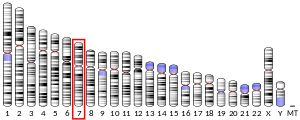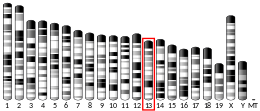Secreted frizzled-related protein 4 is a protein that in humans is encoded by the SFRP4 gene.[5][6]
Function
editSecreted frizzled-related protein 4 (SFRP4) is a member of the SFRP family that contains a cysteine-rich domain homologous to the putative Wnt-binding site of Frizzled proteins. SFRPs act as soluble modulators of Wnt signaling. The expression of SFRP4 in ventricular myocardium correlates with apoptosis related gene expression.[6]
Biallelic, recessive variants in the SFRP4 gene result in the genetic disorder of bone, Pyle disease,[7] that is characterized by a failure of long bone remodeling with increased fragility. The association between SFRP4 deficiency and Pyle disease has highlighted the importance of SFRP4 in the formation of the bone cortex, and of the importance of bone cortex for the mechanical stability of long bone elements.
SFRP4 is a hub gene in a Type 2 Diabetes-associated gene coexpression module in human islets, and reduces glucose-induced insulin secretion through decreased β-cell exocytosis. Expression and release of SFRP4 from islets is enhanced by interleukin-1β. SFRP4 is elevated in serum several years before clinical diagnosis of Type 2 Diabetes. Individuals who have above-average levels of SFRP4 in the blood are five times more likely to develop diabetes in the next few years than those with below-average levels.[8] SFRP4 concentration seems to correlate with obesity and systemic insulin resistance [9]
References
edit- ^ a b c GRCh38: Ensembl release 89: ENSG00000106483 – Ensembl, May 2017
- ^ a b c GRCm38: Ensembl release 89: ENSMUSG00000021319 – Ensembl, May 2017
- ^ "Human PubMed Reference:". National Center for Biotechnology Information, U.S. National Library of Medicine.
- ^ "Mouse PubMed Reference:". National Center for Biotechnology Information, U.S. National Library of Medicine.
- ^ Abu-Jawdeh G, Comella N, Tomita Y, Brown LF, Tognazzi K, Sokol SY, Kocher O (April 1999). "Differential expression of frpHE: a novel human stromal protein of the secreted frizzled gene family, during the endometrial cycle and malignancy". Laboratory Investigation; A Journal of Technical Methods and Pathology. 79 (4): 439–447. PMID 10211996.
- ^ a b "Entrez Gene: SFRP4 secreted frizzled-related protein 4".
- ^ Kiper PO, Saito H, Gori F, Unger S, Hesse E, Yamana K, et al. (June 2016). "Cortical-Bone Fragility--Insights from sFRP4 Deficiency in Pyle's Disease". The New England Journal of Medicine. 374 (26): 2553–2562. doi:10.1056/nejmoa1509342. PMC 5070790. PMID 27355534.
- ^ Mahdi T, Hänzelmann S, Salehi A, Muhammed SJ, Reinbothe TM, Tang Y, et al. (November 2012). "Secreted frizzled-related protein 4 reduces insulin secretion and is overexpressed in type 2 diabetes". Cell Metabolism. 16 (5): 625–633. doi:10.1016/j.cmet.2012.10.009. PMID 23140642.
- ^ Hörbelt T., Knebel B., Fahlbusch P., Barbosa D., de Wiza D.H., Van de Velde F., Van Nieuwenhove Y., Lapauw B., Thoresen G.H., Al-Hasani H. The adipokine sFRP4 induces insulin resistance and lipogenesis in the liver. Biochim. Biophys. Acta. Mol. Basis Dis. 2019;1865:2671–2684. doi: 10.1016/j.bbadis.2019.07.008
Further reading
edit- Rattner A, Hsieh JC, Smallwood PM, Gilbert DJ, Copeland NG, Jenkins NA, Nathans J (April 1997). "A family of secreted proteins contains homology to the cysteine-rich ligand-binding domain of frizzled receptors". Proceedings of the National Academy of Sciences of the United States of America. 94 (7): 2859–2863. Bibcode:1997PNAS...94.2859R. doi:10.1073/pnas.94.7.2859. PMC 20287. PMID 9096311.
- Wolf V, Ke G, Dharmarajan AM, Bielke W, Artuso L, Saurer S, Friis R (November 1997). "DDC-4, an apoptosis-associated gene, is a secreted frizzled relative". FEBS Letters. 417 (3): 385–389. doi:10.1016/S0014-5793(97)01324-0. PMID 9409757. S2CID 40129368.
- Schumann H, Holtz J, Zerkowski HR, Hatzfeld M (February 2000). "Expression of secreted frizzled related proteins 3 and 4 in human ventricular myocardium correlates with apoptosis related gene expression". Cardiovascular Research. 45 (3): 720–728. doi:10.1016/S0008-6363(99)00376-4. PMID 10728394.
- Strausberg RL, Feingold EA, Grouse LH, Derge JG, Klausner RD, Collins FS, et al. (December 2002). "Generation and initial analysis of more than 15,000 full-length human and mouse cDNA sequences". Proceedings of the National Academy of Sciences of the United States of America. 99 (26): 16899–16903. Bibcode:2002PNAS...9916899M. doi:10.1073/pnas.242603899. PMC 139241. PMID 12477932.
- Berndt T, Craig TA, Bowe AE, Vassiliadis J, Reczek D, Finnegan R, et al. (September 2003). "Secreted frizzled-related protein 4 is a potent tumor-derived phosphaturic agent". The Journal of Clinical Investigation. 112 (5): 785–794. doi:10.1172/JCI18563. PMC 182208. PMID 12952927.
- Wissmann C, Wild PJ, Kaiser S, Roepcke S, Stoehr R, Woenckhaus M, et al. (October 2003). "WIF1, a component of the Wnt pathway, is down-regulated in prostate, breast, lung, and bladder cancer". The Journal of Pathology. 201 (2): 204–212. doi:10.1002/path.1449. PMID 14517837. S2CID 45143454.
- Horvath LG, Henshall SM, Kench JG, Saunders DN, Lee CS, Golovsky D, et al. (January 2004). "Membranous expression of secreted frizzled-related protein 4 predicts for good prognosis in localized prostate cancer and inhibits PC3 cellular proliferation in vitro". Clinical Cancer Research. 10 (2): 615–625. doi:10.1158/1078-0432.CCR-0707-03. PMID 14760084.
- Gerhard DS, Wagner L, Feingold EA, Shenmen CM, Grouse LH, Schuler G, et al. (October 2004). "The status, quality, and expansion of the NIH full-length cDNA project: the Mammalian Gene Collection (MGC)". Genome Research. 14 (10B): 2121–2127. doi:10.1101/gr.2596504. PMC 528928. PMID 15489334.
- Ahn J, Chung KS, Kim DU, Won M, Kim L, Kim KS, et al. (November 2004). "Systematic identification of hepatocellular proteins interacting with NS5A of the hepatitis C virus". Journal of Biochemistry and Molecular Biology. 37 (6): 741–748. doi:10.5483/bmbrep.2004.37.6.741. PMID 15607035.
- He B, Lee AY, Dadfarmay S, You L, Xu Z, Reguart N, et al. (February 2005). "Secreted frizzled-related protein 4 is silenced by hypermethylation and induces apoptosis in beta-catenin-deficient human mesothelioma cells". Cancer Research. 65 (3): 743–748. doi:10.1158/0008-5472.743.65.3. PMID 15705870. S2CID 29417081.
- Berndt TJ, Bielesz B, Craig TA, Tebben PJ, Bacic D, Wagner CA, et al. (January 2006). "Secreted frizzled-related protein-4 reduces sodium-phosphate co-transporter abundance and activity in proximal tubule cells". Pflügers Archiv. 451 (4): 579–587. doi:10.1007/s00424-005-1495-2. PMID 16151791. S2CID 23039636.
- Feng Han Q, Zhao W, Bentel J, Shearwood AM, Zeps N, Joseph D, et al. (January 2006). "Expression of sFRP-4 and beta-catenin in human colorectal carcinoma". Cancer Letters. 231 (1): 129–137. doi:10.1016/j.canlet.2005.01.026. PMID 16356838.
- Urakami S, Shiina H, Enokida H, Kawakami T, Kawamoto K, Hirata H, et al. (April 2006). "Combination analysis of hypermethylated Wnt-antagonist family genes as a novel epigenetic biomarker panel for bladder cancer detection". Clinical Cancer Research. 12 (7 Pt 1): 2109–2116. doi:10.1158/1078-0432.CCR-05-2468. PMID 16609023.
- Horvath LG, Lelliott JE, Kench JG, Lee CS, Williams ED, Saunders DN, et al. (July 2007). "Secreted frizzled-related protein 4 inhibits proliferation and metastatic potential in prostate cancer". The Prostate. 67 (10): 1081–1090. doi:10.1002/pros.20607. PMID 17476687. S2CID 84263583.





